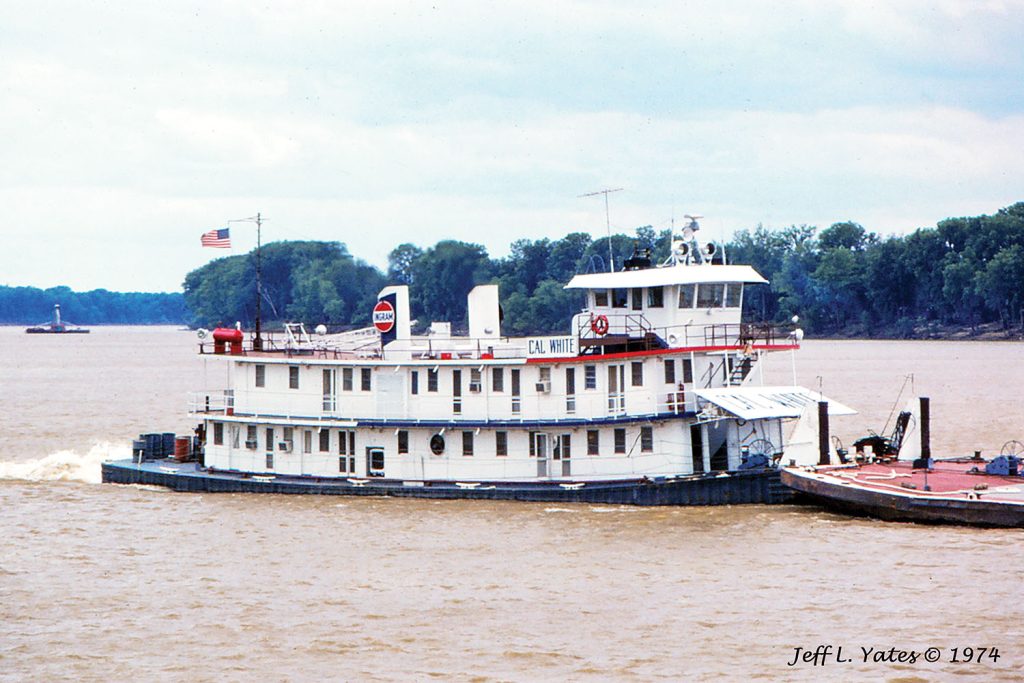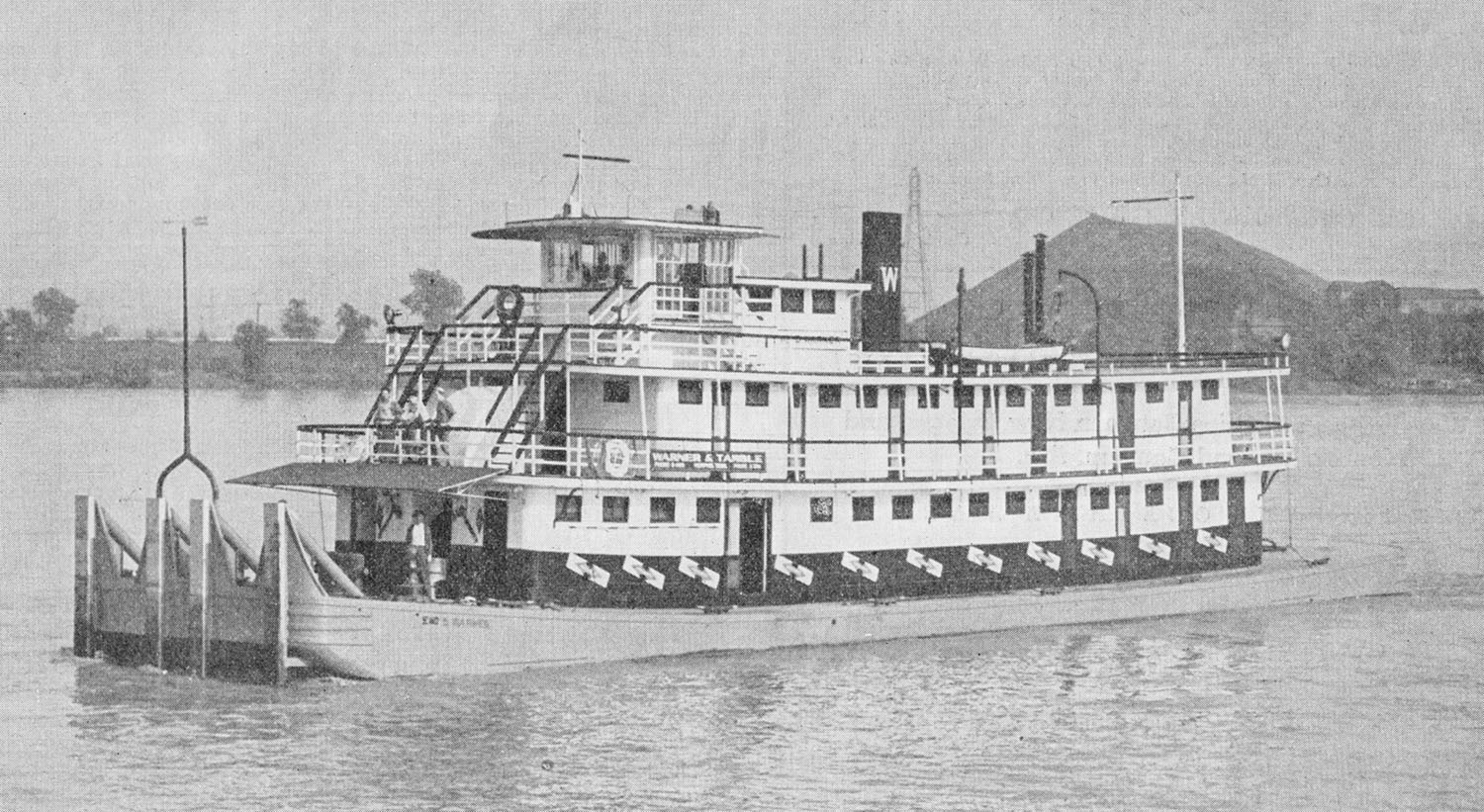Since this is the IMX issue, it is appropriate to feature a boat that has ties to the host city of Nashville, Tenn. The boat selected was not built at that city but would later be rebuilt there and for many years was owned by companies headquartered in Nashville.
The April 23, 1938, issue of The Waterways Journal carried a story on page five next to the masthead that named a towboat nearing completion by Warner & Tamble at Memphis, Tenn. It stated that the new vessel was to be christened Edward B. Warner in honor of Capt. Edward Warner, an uncle of Capt. Russell V. Warner, one of the owners. Capt. E.B. Warner was licensed for service on the Mississippi, Arkansas and St. Francis rivers, and he had begun his career “in the early ‘70s” (1870s). The boat, which would be twin screw and 1,200 hp., was to be ready for a trial run about the middle of May. Capt. Russell Warner planned to be aboard as master.
The June 4, 1938, issue of the WJ had a feature story detailing the new boat. It was now identified as the Edw. B. Warner. It was said to be “the most costly river craft built at Memphis in several years, and she is the sixth boat by her owners, Warner and Tamble, since they started in business about 1928.” The Warner had a steel hull that was 127 by 28 feet, the seams of which had “been riveted and double welded.” Power was provided by a pair of Busch-Sulzer Bros. diesel engines that provided 1,200 hp.
The lower cabin of the boat was also of steel construction and contained the engineroom forward, with five crew rooms and bath facilities in the after portion. The full upper cabin was wooden and had six “beautifully fitted” staterooms for the officers, some with private baths. A “main salon” was located there, as was the captain’s office, galley and separate dining areas for officers and crew. Above this cabin and situated forward was an elevated pilothouse, and aft of that was a small cabin that held a radio room and berthing and bath facilities for the radio operator. The call letters assigned to the vessel were WNIV. A single smokestack was behind the radio room.
The Warner departed Memphis on May 20 on long-term charter to the Mississippi Valley Barge Line Company. It arrived at St. Louis on May 25 with a tow of five barges that it had picked up at Cairo. The initial crew included Capt. W. Morrison Warner, master; Capts. E.O. Hines and Clarence Fultz, pilots; C. Ousler, chief engineer; Joseph Cavola, first assistant engineer; Mac Johnson, oiler; Joe Woods, mate; C.A. Renner, machinist; and Jim Duncan, Morgan Long, Ike Morman and Paul Crumrin, deckhands. Capt. R.V. Warner was also aboard and left the boat at St. Louis to return to Memphis. Interestingly, this WJ issue that featured this new boat of partial wooden construction and steamboat-style cabins had on the cover the “ultra-streamlined, all steel” J.H. Duffy (WJ August 7, 2023) in an ad for St. Louis Shipbuilding & Steel Company.
While identified in these articles as first the “Edward B. Warner” and then “Edw. B. Warner,” the actual name of the boat was Ewd. B. Warner. It continued in service to the builder/owners Warner & Tamble until 1953 when, according to the Inland River Record, it was sold to West Tennessee Limestone Company, which was affiliated with the Barrett Line, and renamed Elmore Foster. This company was shown as being headquartered in Nashville. In this same timeframe, the List of U.S. Merchant Vessels shows that the boat was owned by an individual named Cale P. Haun, and the home port was Nashville.
On October 11, 1956, the Elmore Foster was involved in a collision with the Harry Truman of Federal Barge Line some 17 miles below Memphis. The Foster caught fire and burned. It was taken to Nashville Bridge Company at Nashville, where it was completely rebuilt. During this rebuild it was also repowered with a pair of Enterprise DMG38 diesels and Western 2:1 reduction gears. It then boasted 2,100 hp. When it re-entered service it was named Caleb H (for this “Cale” Haun listed as owner, perhaps?). The appearance was little changed other than for a more modern-looking pilothouse, no radio room cabin and now having twin stacks.
The 1963 IRR shows the Caleb H as owned by the Barrett Line, a division of Ingram Corporation, Nashville. In 1964 it was renamed Cal White and was owned by Ingram Barge Company. As the Cal White, the boat was seen all over the inland river system. Capt. Cecil Duncan, retired former port captain for Western Kentucky Navigation and still working as an occasional trip pilot, spent time on the Cal White as a youngster after attending the National River Academy. He recently recalled his time aboard and how he was shocked on the first opportunity he had to blow the whistle. He had noticed a line with a handle hanging from the ceiling and pulled that expecting to hear a loud whistle. Instead, the overhead light came on. He later found that the whistle had a brass pedal on the floor. He keeps a framed photo of the White at his home to this day.

In 1977, the Cal White was sold to Granco Marine Service, Paducah, Ky., and was towing on the Upper Mississippi and Illinois rivers. The boat caught fire the evening of September 22, 1978, while upbound at Mile 249 on the Upper. The area was somewhat isolated, and though several other towboats eventually responded, the boat burned all night and ultimately sank about 10 a.m. the next day. This brought the 40-year career of this fairly unique vessel to a close.
Many thanks again to Capt. Jeff Yates for digging in his dusty files.
Caption for top photo: The new Ewd. B. Warner in a Busch-Sulzer ad in the November 19, 1938, WJ. (Author’s collection)
Capt. David Smith can be contacted at davidsmith1955obc@gmail.com.




